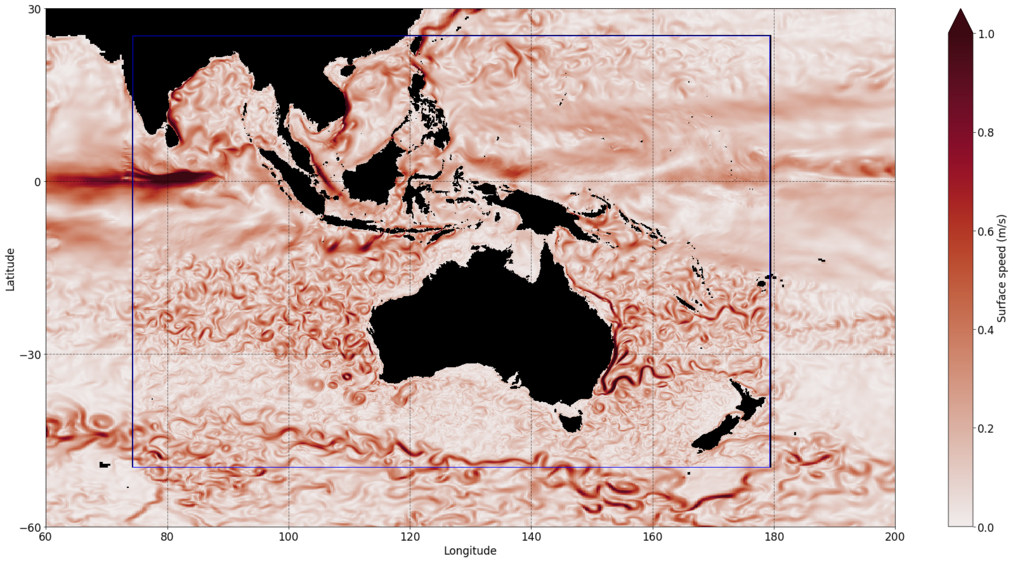IndoArchipel-2
Regional sea level changes in the marginal seas of southeast Asia: Mechanisms and projections of possible 21st-century trends (IndoArchipel-2)
Background
The western tropical Pacific represents an area with strong interannual and decadal sea level variations (figure 1). While the changes in the open ocean are basically understood in terms of wind-driven redistributions of upper-ocean waters associated with major climate modes (ENSO, PDO), much less is known about the modification of these signals in the Indonesian Archipelago and the marginal seas and shelf areas of southeast Asia, i.e., about the relative role of remote and local forcing mechanisms. Projections of future trends in these areas are hampered since present climate models do not resolve the complex flow structures of the boundary currents and flows through the narrow passages, and are thus lacking potentially important processes, e.g., for connecting the changes in the western Pacific with the Indian Ocean, and for a realistic propagation of deep ocean changes onto the shelf areas and coastal waters.
Objectives
The goal of this project is to contribute to the integrated analysis of sea level change in the coastal areas and island states of South-East Asia by devising a programme of experimentation with high-resolution ocean models aiming at
- a regionally refined characterization of contemporary sea level variability over the continental shelves and marginal seas of this area;
- assessment of possible shifts in forcing mechanism of the ITF transport and related heat transport and sea level signals. Historic changes of the ITF transport can be related to changes of the wind field of the tropical Indo-Pacifc domain. In contrast to these findings recent studies based on CMIP5 projections predict a weakening of the ITF transport during the 21st century that is not related to the wind forcing of the tropical Pacific. Instead changes in the deep ocean circulation and density structure both in the Pacific Ocean and in the Pacific domain of the Southern Ocean seem to alter the characteristics of the deep and bottom waters that is exported in the western tropical Pacific with effects on sea level tendencies and the pressure forcing between the Pacific and Indian Ocean. The exact mechanism are still unknown.
- providing regionally refined projections of the range of future regional sea level changes and their uncertainties that are to be expected from the projected trends in the atmospheric conditions simulated in 21st- century climate scenarios (CMIP6).
Methods
The research program utilizes a hierarchy of high-resolution global ocean circulation models. Building on a global (‘eddy-permitting’) model configuration with ¼°-grid resolution (ORCA025), a novel configuration with regionally enhanced resolution of 1/20° has been developed during the first phase of the project. The high-resolution domain spans the area of interest, i.e., the South-East Asian shelf areas and Indonesian Archipelago, but extends from the western tropical Pacific to the eastern Indian Ocean, and thus includes dynamical regimes deemed important for the transformation of the basin-scale signals, such as the complex bathymetric features and boundary currents (figure 2).
The main element of the project’s work plan is a programme of numerical experimentation consisting of the following sets of simulations:
(i) Regionally-refined simulations utilizing the model configuration with the 1/20°-nest, addressing the question of how the interaction of changes in the deep ocean with the complex bathymetry and the local forcing conspire in the generation of sea level patterns in the shallow seas and shelves of the study area. To which degree are the local sea level changes governed by the large-scale atmospheric forcing and reflect the basin-scale variability modes? To what extent are the deep ocean signals modified by interactions with the bathymetry, what is the effect of changes in the boundary currents for the local current dynamics and associated sea level patterns in marginal seas and passages of the Archipelago? How does the bathymetric influence change at longer time scales, and could thus be affected by future trends in the vertical density structure due to a progressing deep ocean warming?
(ii) A series of experiments with perturbations in the density structure of the Southern Ocean and the Pacific to alter the transport rates of deep water and the upwelling of those water masses in the Pacific will be aimed at isolating the forcing factors behind possible future trends of the ITF transport.
(ii) The high-resolution nested model configuration will be utilized in ‘projection’-experiments directed at delineating the possible future trends of regional sea level as a consequence of specific changes in the atmospheric forcing during the next 50-100 years. The main purpose of the high-resolution model is here to determine a regionally much more refined projection of sea level trends than in the original climate model projections which, owing to their coarse resolution, do not resolve the complex geography nor the current-bathymetry interactions potentially important in the area.
Publications
Ummenhofer, Caroline et al. (2020): Late 20th-century Indian Ocean heat content gain masked by wind forcing. Geophys. Res. Letters 47, e2020GL088692.
Wagner, P., M. Scheinert & C. W. Böning (2021): Contribution of buoyancy fluxes to tropical Pacific sea level variability. Ocean Science, 17, 1103 – 1113.
Wagner, P. & C. W. Böning (2021): Decadal sea level variability in the Australasian Mediterranean Sea. Ocean Science, 17, 1473 – 1483.
Ryan, Svenja et al. (2021): Depth structure of Ningaloo Nino/Nina events and associated drivers. J. Climate 34, 1767 – 1788 (2021)
Wang, Shouyi et al. (2023): Freshwater contribution to decadal variability of the Indonesian throughflow. Geophys. Res. Letters 50, e2023GL103906.
PhD thesis:
Wagner, P. (2021): Decadal sea-level variability in the Indo-Pacific region: Development and application of a high-resolution model. Dissertation, Christian-Albrechts-Universität zu Kiel, 137 pp.


